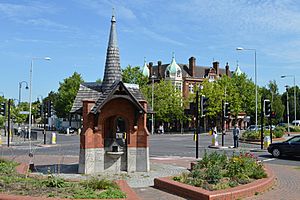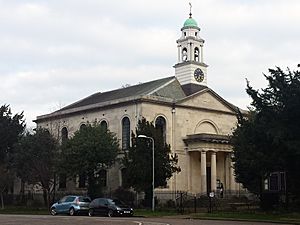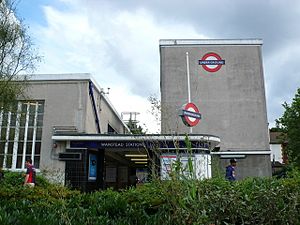Wanstead facts for kids
Quick facts for kids Wanstead |
|
|---|---|
 Wanstead drinking fountain, built to celebrate Queen Victoria’s diamond jubilee |
|
| Population | 11,543 (2011 Census. Ward) |
| OS grid reference | TQ405885 |
| London borough | |
| Ceremonial county | Greater London |
| Region | |
| Country | England |
| Sovereign state | United Kingdom |
| Post town | LONDON |
| Postcode district | E11 |
| Dialling code | 020 |
| Police | Metropolitan |
| Fire | London |
| Ambulance | London |
| EU Parliament | London |
| UK Parliament |
|
| London Assembly |
|
Wanstead (/ˈwɒnstɛd/) is a lively area in East London, England. It's part of the London Borough of Redbridge. Wanstead is about 8 miles northeast of Charing Cross, a famous spot in central London.
Historically, Wanstead was an old parish in Essex. It became an urban district in 1894. Later, from 1937 to 1965, it was part of the Municipal Borough of Wanstead and Woodford. After that, it joined the London Borough of Redbridge. Wanstead was also involved in the M11 link road protest in the 1990s. This protest led to the building of the A12, which now runs through the town.
The area has many green spaces that are part of Epping Forest. These include the open fields of Wanstead Flats and the woods of Wanstead Park. Long ago, a Roman villa might have stood in Wanstead Park. Later, Wanstead Hall, a large manor house, was built there. The park, with its beautiful artificial lakes, was once part of the huge estate of Wanstead House. This grand home was built by Richard Child, 1st Earl Tylney and stood from 1722 to 1825.
Contents
History of Wanstead
What Does the Name "Wanstead" Mean?
The name Wanstead likely comes from Saxon times. It was first written down in 1065 as "Wenstede." Experts believe the name comes from two old Anglo-Saxon words: waenn, meaning a hill or mound, and stede, meaning a place or settlement. So, it could mean "hill settlement." Another idea is that the first part means "wagon," but the full meaning isn't totally clear.
Wanstead and the Stars: Astronomy Discoveries
In 1707, a famous astronomer named James Pound became the rector (a type of priest) in Wanstead. In 1717, a group of scientists called the Royal Society lent him a very long telescope lens. Pound set it up in Wanstead Park.
Using this telescope, Pound watched the five known moons of Saturn. His observations helped another scientist, Halley, make better calculations about how these moons move. Even the famous Isaac Newton used Pound's measurements of Jupiter and Saturn for his own scientific work.
Pound also taught his nephew, James Bradley, about astronomy. They made many observations together. For example, they watched Mars in 1719 and Mercury in 1723. In 1718, they were the first to measure the distance between two stars that are very close together.
In 1727, James Bradley started his own observations using a telescope at the rectory in Wanstead. This is now where Wanstead High School stands. His telescope had a wide view. Over two years, he carefully recorded the positions of many stars. His work helped him discover something called the "aberration of light." This discovery helped scientists understand how light travels and how it affects what we see in space.
The George Pub: A Story in Stone
The building you see today for The George pub was built in 1903. However, there has been a pub on this spot since at least 1716! On the side of the pub, there's a special stone plaque from 1752. It used to be part of the older pub building.
The plaque has a funny poem carved into it:
- In Memory of
- Ye Cherry Pey
- As cost 1/2 a Guiney
- Ye 17 of July
- That day we had good cheer
- I hope to so do maney a Year
- R C 1752 D Jerry
People have told many stories about this plaque. One tale says local workers stole a cherry pie and were fined half a guinea (which was a lot of money, about 52.5 pence today). But the most likely story is that the pub owner in 1752, David Jersey (whose name became "D Jerry" on the plaque over time), put it there. It was to remember a big feast that included a giant cherry pie!
Huge pies were popular at festivals in Essex in the 1700s. Wanstead was also known for its cherry orchards until the 1830s. The poet Thomas Hood, who lived in Wanstead, even wrote about them.
Schools and Learning in Wanstead
Wanstead has a long history of education.
- The Royal Commercial Travellers Schools were in Wanstead from 1845 to 1855. These schools helped children of traveling salespeople who had died or couldn't work anymore. They provided housing, food, clothes, and education for up to 130 children.
- The Royal Merchant Navy School moved to Wanstead in 1862. It helped 300 children whose parents worked in the Merchant Navy and had passed away. This building later became a hospital.
- The Royal Wanstead School was near Eagle Pond until about 1970. Today, a Crown Court stands on that site.
Wanstead is home to a large secondary school called Wanstead High School. There are also several primary schools, including Wanstead Church, Our Lady of Lourdes RC, Aldersbrook, and Nightingale.
From 1957 to 1987, there was another secondary school called Nightingale Secondary Modern School. Nightingale Primary School is still there today.
Forest School, Walthamstow is also close to Wanstead, near Eagle Pond.
Places of Worship
The beautiful church of St Mary the Virgin, Wanstead was finished in 1790. It is now a very important historic building. Inside, you can see a large monument dedicated to Josiah Child. Later, in the 1860s, two more churches were built: Christ Church (Anglican) and Wanstead Congregational Church. The local Catholic Church, Our Lady of Lourdes, Wanstead, opened in 1928.
Military History
During World War II, the tunnels of the Wanstead underground station were used for making aircraft. The station wasn't open to the public yet, so it was a secret factory!
Wanstead Flats was also important during the war. It had anti-aircraft batteries to protect London from air attacks. It also served as barracks for soldiers before D-Day and later as a prisoner-of-war camp.
Getting Around: Underground Stations
Wanstead has two London Underground stations on the Central line. They are located at each end of the High Street that runs through the town: Snaresbrook and Wanstead.
Famous People from Wanstead
Many interesting people have lived in Wanstead over the years:
- Clive Burr, a famous drummer from bands like Iron Maiden.
- Robert Dudley, a close friend of Queen Elizabeth I, who passed away in his Wanstead home.
- Thomas Hood, a well-known poet.
- Peter Goddard, a physicist and journalist.
- William Penn, who founded the state of Pennsylvania in America.
- James Pound, the astronomer we learned about earlier.
- Richard Brinsley Sheridan, a famous writer of plays.
- Jessie Wallace, an actress.
- Tom Watt, an actor.
- Joseph Wilton, a sculptor.





